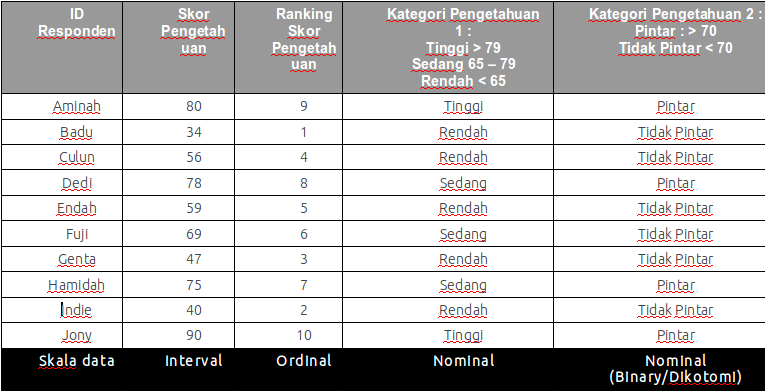Unlocking Insights: Understanding Interval Scales and Their Applications
In a world overflowing with data, understanding how to measure and interpret information is crucial. Whether you're a seasoned researcher or just starting to explore the world of statistics, you've likely encountered different ways to categorize data. One such method, the interval scale, plays a key role in providing valuable insights from numerical data.
Imagine you're analyzing the results of a customer satisfaction survey. You ask respondents to rate their experience on a scale of 1 to 5, with 1 being "very dissatisfied" and 5 being "very satisfied." This scale, where the difference between each point is meaningful and consistent, exemplifies an interval scale. It allows you to not only rank responses but also quantify the differences between them.
Unlike nominal scales, which simply categorize data (like colors or types of fruit), or ordinal scales, which introduce order without quantifiable differences (like ranking movies from best to worst), interval scales offer a higher level of precision. This is because they maintain equal intervals between each point on the scale. The difference between a 2 and a 3 is the same as the difference between a 4 and a 5.
This characteristic opens doors to more sophisticated statistical analyses. With interval data, we can calculate meaningful averages, determine standard deviations, and perform various statistical tests that wouldn't be possible with nominal or ordinal data. Think about measuring temperature in Celsius. The difference between 10°C and 20°C is the same as the difference between 20°C and 30°C, making it possible to perform calculations like finding the average temperature over a week.
The concept of interval scales has been instrumental in advancing various fields, from social sciences and market research to healthcare and finance. Whether it's tracking changes in stock prices, analyzing survey responses, or measuring patient temperature, interval scales provide a robust framework for gathering, analyzing, and interpreting numerical data.
Advantages and Disadvantages of Interval Scales
Like any measurement tool, interval scales come with their own set of advantages and disadvantages. Understanding these can help researchers choose the most appropriate scale for their specific needs.
| Advantages | Disadvantages |
|---|---|
| Allows for quantifiable comparisons and statistical analysis. | Lack of a true zero point limits certain calculations (e.g., ratios). |
| Provides a clear and consistent measure of differences between data points. | Susceptible to subjective interpretation of scale points by respondents. |
| Facilitates the calculation of meaningful averages and standard deviations. | May not capture the full range of nuances in certain subjective measures. |
Examples of Interval Scales
Here are five real-world examples of interval scales:
- Temperature (Celsius or Fahrenheit): The difference between 10°C and 20°C is the same as the difference between 20°C and 30°C.
- IQ Scores: An IQ score of 100 is considered average, and each point difference represents a consistent difference in cognitive ability.
- Calendar Years: The year 2000 is as far from the year 2050 as the year 2050 is from the year 2100.
- Sea Level: Sea level, often used as a reference point for measuring elevation, is an example of an interval scale.
- Likert Scales (with caveats): While often treated as interval scales, Likert scales (e.g., strongly agree to strongly disagree) require careful consideration as the intervals may not be perfectly equal in the minds of all respondents.
Frequently Asked Questions about Interval Scales
Here are eight common questions about interval scales:
- What is the key difference between interval and ratio scales? Ratio scales have a true zero point, allowing for ratio calculations. For example, weight in kilograms is a ratio scale because 0 kg represents the absence of weight.
- Can you provide some examples of statistical analyses that can be performed on interval data? Mean, median, mode, standard deviation, t-tests, ANOVA, and correlation analysis are some examples.
- How do interval scales impact data visualization? Interval scales allow for the use of histograms, line graphs, and scatter plots to visualize data distributions and relationships.
- What are some common challenges in using interval scales? Ensuring equal intervals between scale points and minimizing subjective interpretation are key challenges.
- How can I determine if an interval scale is appropriate for my research? Consider the nature of your data, the level of precision required, and the types of analyses you plan to conduct.
- What are some best practices for designing effective interval scales? Clearly define scale points, ensure equal intervals, and provide context to minimize ambiguity.
- Are Likert scales considered interval or ordinal scales? While often treated as interval scales, Likert scales require careful consideration as the intervals may not be perfectly equal in the minds of all respondents.
- Where can I find additional resources to learn more about interval scales? Statistics textbooks, online courses, and research articles provide in-depth information on this topic.
Conclusion: The Enduring Relevance of Interval Scales in a Data-Driven World
In an age where data informs decisions across industries, understanding the nuances of measurement scales is essential. Interval scales, with their ability to quantify differences and support advanced statistical analysis, remain invaluable tools for researchers, analysts, and anyone seeking to extract meaningful insights from numerical data. Whether you're exploring customer sentiment, analyzing scientific data, or tracking market trends, recognizing the power and limitations of interval scales empowers you to make more informed decisions and unlock a deeper understanding of the world around us. As you navigate the ever-expanding landscape of data, remember the crucial role that interval scales play in shaping our interpretations and driving informed action.
Unlocking creativity the power of cartoon house images
Ab montag den oder dem mastering the monday mystery
Trailer brakes locking up when reversing troubleshooting and prevention













